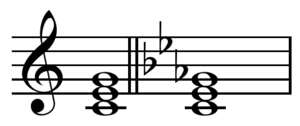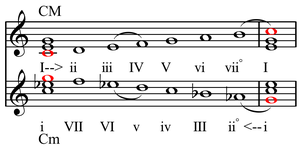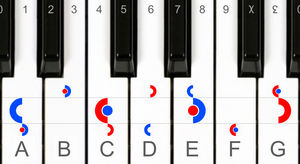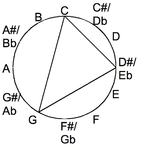Major and minor
In Western music, the adjectives major and minor can describe a musical composition, movement, section, scale, key, chord, or interval.
Major and minor are frequently referred to in the titles of classical compositions, especially in reference to the key of a piece.
Intervals and chords[edit | edit source]



<templatestyles src="Multiple_image/styles.css" />
With regard to intervals, the words major and minor mean large and small. Thus, a major third is a slightly wider interval than a minor third. The second, third, sixth, and seventh intervals (and compound intervals based on them) may be either major or minor. In Western music, a minor chord "sounds darker than a major chord".[1] A minor interval or chord
The other uses of major and minor generally refer to musical structures that contain a major third interval or a minor third interval, respectively. A major scale is one in which the third scale degree is a major third interval above the tonic note, while the third scale degree in a minor scale is a minor third interval above the tonic. Similarly, the second note in a major chord or major triad is a major third interval above the cord's root, whereas the second note in a minor chord or minor triad is a minor third interval above the root.
Keys[edit | edit source]

The hallmark that distinguishes major keys from minor is whether the third scale degree is major or minor. "The crucial difference is that in the minor scale there is only a half step between "2nd and 3rd note" and between "5th and 6th note" as compared to the major scales where the difference between "3rd and 4th note" and between "7th and 8th note" is half."[1] This alteration in the third degree "greatly changes" the mood of the music, and "music based on minor scales tends to" be considered to "sound serious or melancholic".[1]
Minor keys[edit | edit source]
The minor scale can be described in two different ways. One way is to consider it as the sixth mode of a major scale, while the other is to call it a variation of the major scale, with the third scale degrees always lowered (or altered) and the sixth and seventh degrees often lowered.
Minor keys are sometimes said to have a more interesting, possibly darker sound than plain major scales.[2] The minor mode, with its variable sixth and seventh degrees, offers nine notes, in C: C-D-E♭-F-G-A♭-A♮-B♭-B♮, over the major mode's seven, in C: C-D-E-F-G-A-B.
Harry Partch considers minor as, "the immutable faculty of ratios, which in turn represent an immutable faculty of the human ear."[3] The minor key and scale are also considered less justifiable than the major, with Paul Hindemith calling it a "clouding" of major, and Moritz Hauptmann calling it a "falsehood of the major".[3]
Relative major and minors[edit | edit source]
The relative minor of a major key has the same key signature and starts down a minor third (or equivalently up a major sixth); for example, the relative minor of G major is E minor. Similarly the relative major of a minor key starts up a minor third (or down a major sixth); for example, the relative major of F minor is A♭ major.
Relation to musical 'mode'[edit | edit source]
Contrastingly, changes of mode, which would involve the alteration of the third, and mode mixture, are often analyzed as minor or trivial changes unless structurally supported because the root and overall key and tonality remain unchanged. This is in contrast with, for instance, transposition. Transposition is done by moving all intervals up or down a certain constant interval, and does change key, but does not change mode, which requires the alteration of intervals. The use of triads only available in the minor mode, such as the use of A♭-major in C major, is relatively decorative chromaticism, considered to add color and weaken sense of key without entirely destroying or losing it.
Scales and chords[edit | edit source]
Major and minor chords may each be found in both the major and minor scales, constructed on different degrees of each. For example, in the parallel keys on C on the first degree of the major scale a major chord (C-E-G) is constructed while on the first degree of the minor scale a minor chord (C-E♭-G) is constructed:
| Scale | 1 | 2 | 3 | 4 | 5 | 6 | 7 |
|---|---|---|---|---|---|---|---|
| Major | major | minor | minor | major | dominate | minor | diminished |
| Natural minor | minor | diminished | major | minor | minor | major | dominate |
| Harmonic minor | minor | diminished | augmented | minor | major | dominate | diminished |
Minor scales[edit | edit source]
There are three variations of the minor scale: natural, harmonic and melodic.
In the natural minor scale, all scale degrees are the same as the relative major. For example, in the "A minor natural scale", the notes are A-B-C-D-E-F-G. In a harmonic minor scale, the 7th note is raised a semitone, both ascending and descending (A-B-C-D-E-F-G♯). In a melodic minor scale, the 6th and 7th notes ascending are raised a semitone (A-B-C-D-E-F♯-G♯), and descending, the 6th and 7th notes are natural (A-B-C-D-E-F♮-G♮).
Intonation and tuning[edit | edit source]
Underlying perceived musical tuning of intervals is the frequency relationship expressed as a fraction. Simple fractions can sound more harmonious than complex fractions; for instance an octave is a simple 2:1 ratio and a fifth, also concordant is the relatively simple 3:2 ratio. The table of below gives approximations of a scale to ratios that are rounded towards being as simple as possible.
| C | D | E | F | G | A | B | C |
|---|---|---|---|---|---|---|---|
| 1 | 9/8 | 5/4 | 4/3 | 3/2 | 5/3 | 15/8 | 2 |
In just intonation, a minor chord is often (but not exclusively) tuned in the frequency ratio 10:12:15 ( play (help·info)). In 12-TET, or twelve-tone equal temperament (now the most common tuning system in the West), a minor chord has 3 semitones between the root and third, 4 between the third and fifth, and 7 between the root and fifth. It is represented by the integer notation 0,3,7. The 12-TET fifth (700 cents) is only about two cents narrower than the just perfect fifth (3:2, 702.0 cents), but the 12-TET minor third (300 cents) is noticeably (about 16 cents) narrower than the just minor third (6:5, 315.6 cents). The 12-TET minor third (300 cents) more closely approximates the 19-limit (Limit (music)) minor third (19:16
Play (help·info), 297.5 cents, the nineteenth harmonic) with about two cents error.[4] Ellis proposes that the conflict between mathematicians and physicists on one hand and practicing musicians on the other regarding the supposed inferiority of the minor chord and scale to the major may be explained due to physicists' comparison of just minor and major triads, in which case minor comes out the loser, versus the musicians' comparison of the equal tempered triads, in which case minor comes out the winner since the ET major third is about 14 cents sharp from the just major third (5:4, 386.3 cents), but just about four cents narrower than the 19-limit major third (24:19, 404.4 cents); while the ET minor third closely approximates the 19:16 minor third which many find pleasing.[5]
Advanced theory[edit | edit source]


In the German theory by or derived from Hugo Riemann, the minor mode is considered the inverse of the major mode, an upside down major scale based on (theoretical) undertones rather than (actual) overtones (harmonics) (See also: Utonality). The "root" of the minor triad is thus considered the top of the fifth, which, in the United States, is called "the" fifth. So in C minor, the tonic root is actually G, and the leading tone is A♭ (a halfstep), rather than, in major, the root being C and the leading tone B (a halfstep). Also, since all chords are analyzed as having a tonic, subdominant, or dominant function, with, for instance, in C, A-minor being considered the tonic parallel (US relative), Tp, the use of minor mode root chord progressions in major such as A♭-major—B♭-major—C-major is analyzed as sP—dP—T, the minor subdominant parallel (see: parallel chord), the minor dominant parallel, and the major tonic. (Gjerdingen, 1990)[clarification needed]
See also[edit | edit source]
- Gypsy scale
- List of major/minor compositions
- Music written in all major and/or minor keys
- Otonality and Utonality
Sources[edit | edit source]
- ↑ 1.0 1.1 1.2 Kamien, Roger (2008). Music: An Appreciation, 6th Brief Edition, p. 46. ISBN 978-0-07-340134-8.
- ↑ Craig Wright (September 18, 2008)."Listening to Music: Lecture 5 Transcript" Archived 2010-08-04 at the Wayback Machine., Open Yale Courses.
- ↑ 3.0 3.1 Partch, Harry (2009). Genesis of a Music: An Account of a Creative Work, Its Roots, and Its Fulfillments, p.89-90. ISBN 9780786751006.
- ↑ Alexander J. Ellis (translating Hermann Helmholtz): On the Sensations of Tone as a Physiological Basis for the Theory of Music, page 455. Dover Publications, Inc., New York, 1954.
- ↑ Ellis (1954), p.298. In the 16th through 18th centuries, prior to 12-TET, the minor third in meantone temperament was 310 cents
Play (help·info) and much rougher than the 300 cent ET minor third.
External links[edit | edit source]
- "Proper fingering for piano scales" [major and minor], Music Life.
Template:Key (music) Template:Tonality
| This article uses material from Major and minor on Wikipedia (view authors). License under CC BY-SA 3.0. |


